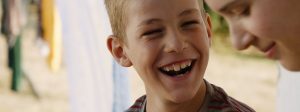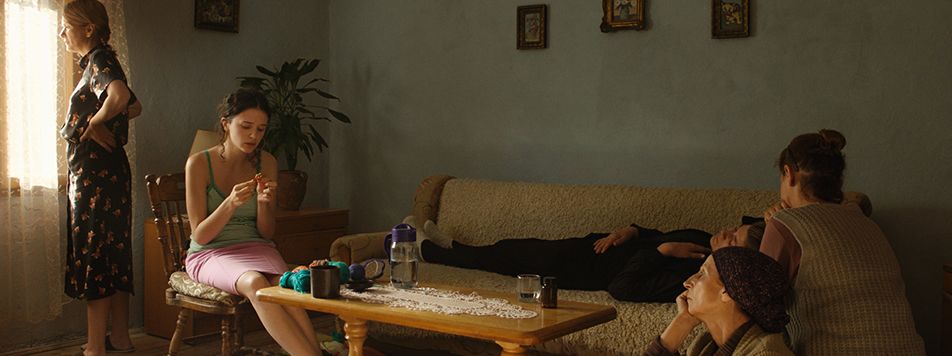In Aga’s House women get to drive the story even as they mostly stay at home.
The title of Lendita Zeqiraj’s debut feature-length film Shpia e Ages (Aga’s House) is a play on words: in Albanian aga is a title for a wealthy landowner, and in Zeqiraj’s movie the main character, Aga (short for Agim), a nine-year-old boy played by Arti Lokaj, is also the proverbial man of the house. In a world mostly devoid of men, Aga, who sells cigarettes on the side to earn a little money, lives in a secluded house on a Kosovo mountaintop together with his mother and four other women.
Zeqiraj’s previous short films (2013’s Balcony and 2018’s Fence) have garnered her a reputation as a steady-handed director, and here she transports the viewer into a magnificent, idyllic landscape in which women preside over a literal safe space.
For most of the film the relationship between the women remains unclear, but it is a gift to follow the animated Lume (Adriana Matoshi) tell her dirty stories to the motley crew made up of the playful warbler Emira (Rozafa Celaj), the elderly Dada Gjyle (Melihate Qena), and the forlorn Kumrije (Shengyl Ismaili), Aga’s mother.
Underneath the cackle and at times infectious hysterics, the relationships between the adult characters remain fraught, especially when the Croatian house-dweller Zdenka (Rebeka Qena) enters the scene. Her outsider status in the group reminds us that despite the sunny weather and lush verdure, the film is firmly set in the aftermath of the Kosovo War, where the legacy of the conflict is the sinister elephant in the room.
The curious and not entirely innocent Aga is the only one who has a close relationship to Zdenka, a deeply depressed woman who pines for her daughter, taken away by her husband. It is Aga who finds her after a suicide attempt, and in effort to save her life, cajoles the conspicous Cera (Basri Lushtaku) – banned from the house because he abused Lume – to take her to the hospital with his car.
Most of the action occurs in or around the house and there’s little plot to recount as Zeqiraj holds her cards close to her chest, building up to a final reveal that to a local audience might feel predictable but is powerful nevertheless.
While Aga’s search for his father, who he believes went missing during the war and might be in a Serbian prison, propels the story forward, it is the female characters and the centrality of women’s lives that make this film an almost unique entity in the unfolding world of Kosovar cinema.
It takes a while for the audience to catch on to the fact that the house is a shelter for women who are fleeing from all types of violence: Dada Gjyle was thrown out of her house after her husband’s death, while Zdenka is alluded to have been kicked out of her home as well; Lume has fled Cera’s violent bouts; Emira was saved from her former boyfriend and trafficker after being trapped in a bordello; and Kumrije had nowhere else to turn to after finding out she was pregnant after being raped by a Serb soldier during the war. Yes, these are battered women, the film seems to be saying, but that’s not all they are.
They squabble among each other, peel peppers, sing, and dance – but most of all they laugh. I watched the film in a packed Kino Armata, where the audience laughed along with the characters, not at them.
Zeqiraj, who also wrote the script, uses joviality to tell even the most horrifying stories. When Lume recounts in confidence to Emira how she was sold off to an old man for the price of a horse, her closest friend, who is at the same time her bully, bursts out laughing.
These bursts of laughter at salty stories, at each other, even at violence itself, reminded me of Helene Cixous’ seminal work “The Laugh of the Medusa,” in which she argues that women have to write/create in order to be able to inscribe femininity into a culture that has been made by men.
Zeqiraj’s film can be read as an inscription of women into a culture – and in this case, cinematography – which has treated their stories as marginal, and their victimization as cheap melodrama. The tight focus of Sofian El Fani’s camera on the characters’ faces in a series of close ups that on any other actors would be ruthless (here Rozafa Celaj excels as Emira) makes it impossible for the audience to look away from faces as they explode into guffaws.
To quote Cixous on the inherent subversiveness of the feminine ecriture (which certainly includes films), it is “volcanic… If she’s a her-she, it’s in order to smash everything, to shatter the framework of institutions, to blow up the law, to break up the ‘truth’ with laughter.”
‘Unhinged’ would be another way to describe these stuck-in-limbo characters whose laughter ruptures the entire fabric of what a war movie is supposed to look like. This laughter saves the script from itself – despite being a women-centred film, I doubt it’d pass the Bechdel test – and points to a resilience that escapes definition.
Indeed, at the end, when, both the audience and Aga, through a literary device masked in the shape of a foreign journalist, get to hear their stories of abuse and rape, it does not feel like a revelation but a performance these women put on for the sake of the shelter director, and of course, our own. I’d much rather hear them laugh.









